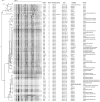Clinical Molecular Epidemiology of Carbapenem-Resistant Klebsiella pneumoniae Among Pediatric Patients in Jiangsu Province, China
- PMID: 33376368
- PMCID: PMC7764961
- DOI: 10.2147/IDR.S293206
Clinical Molecular Epidemiology of Carbapenem-Resistant Klebsiella pneumoniae Among Pediatric Patients in Jiangsu Province, China
Abstract
Purpose: The continuous emergence of carbapenem-resistant Klebsiella pneumoniae (CRKP) has become a serious public health problem globally, especially for children, but data on CRKP infection in pediatric patients are limited. This study aimed to identify epidemiological and molecular patterns of CRKP among pediatric patients in Jiangsu province, China.
Patients and methods: CRKP were consecutively collected from the Children's Hospital of Nanjing Medical University in China from July 2018 to May 2019. Then, CRKP strains were performed for further study: antimicrobial susceptibility testing, drug-resistance determinants screening and homology analysis.
Results: We collected 94 CRKP from 94 children. Overall, bla KPC-2 (79.8%) was the predominant carbapenemase gene, followed by bla NDM-1(14.9%), bla IMP-4 (5.3%) and bla NDM-5(4.3%). Notably, two isolates coharbored bla KPC-2 and bla IMP-4, and two isolates coharbored bla KPC-2 and bla NDM-5. MLST analysis revealed that 14 distinct sequence types (STs) were identified, of which ST11 was the most common sequence type identified. Moreover, two novel STs, ST4854 and ST4855, were detected in this study. PFGE revealed that a predominant cluster consisting of KPC-2-producing CRKP ST11 clone isolates was identified and was distributed mainly in the pediatric intensive care unit (PICU) and cardiac intensive care unit (CCU). Moreover, this is the first report to identify the dissemination of ST716 CRKP coproducing KPC-2 and IMP-4 clones.
Conclusion: Clonal dissemination of KPC-2-producing CRKP ST11 was observed in multiple departments. Moreover, two novel STs (ST4854 and ST4855) were identified, which indicates an increased diversity of CRKP strains. To our knowledge, this is the first report that identified the dissemination of Klebsiella pneumoniae coproducing KPC-2 and IMP-4 clones among children, which represents a significant health risk to pediatric patients. Active surveillance and effective control measures are urgently needed to prevent further transmission of these strains among children.
Keywords: KPC-2; Klebsiella pneumoniae; ST11; carbapenemase; children; clonal dissemination.
© 2020 Kong et al.
Conflict of interest statement
The authors report no conflicts of interest in this work.
Figures



Similar articles
-
Resistance Phenotype and Molecular Epidemiology of Carbapenem-Resistant Klebsiella pneumoniae Isolated from Nanjing Children's Hospital in Jiangsu Province, China.Infect Drug Resist. 2022 Sep 14;15:5435-5447. doi: 10.2147/IDR.S377068. eCollection 2022. Infect Drug Resist. 2022. PMID: 36131812 Free PMC article.
-
Clonal dissemination of KPC-2-producing Klebsiella pneumoniae ST11 and ST48 clone among multiple departments in a tertiary teaching hospital in Jiangsu Province, China.Ann Transl Med. 2019 Dec;7(23):716. doi: 10.21037/atm.2019.12.01. Ann Transl Med. 2019. PMID: 32042732 Free PMC article.
-
Carbapenem-resistant hypermucoviscous Klebsiella pneumoniae clinical isolates from a tertiary hospital in China: Antimicrobial susceptibility, resistance phenotype, epidemiological characteristics, microbial virulence, and risk factors.Front Cell Infect Microbiol. 2022 Dec 21;12:1083009. doi: 10.3389/fcimb.2022.1083009. eCollection 2022. Front Cell Infect Microbiol. 2022. PMID: 36619764 Free PMC article.
-
Outbreak by Ventilator-Associated ST11 K. pneumoniae with Co-production of CTX-M-24 and KPC-2 in a SICU of a Tertiary Teaching Hospital in Central China.Front Microbiol. 2016 Aug 2;7:1190. doi: 10.3389/fmicb.2016.01190. eCollection 2016. Front Microbiol. 2016. PMID: 27531996 Free PMC article.
-
Emergence and nosocomial spread of ST11 carbapenem-resistant Klebsiella pneumoniae co-producing OXA-48 and KPC-2 in a regional hospital in Taiwan.J Med Microbiol. 2018 Jul;67(7):957-964. doi: 10.1099/jmm.0.000771. J Med Microbiol. 2018. PMID: 29873627
Cited by
-
Pandemic one health clones of Escherichia coli and Klebsiella pneumoniae producing CTX-M-14, CTX-M-27, CTX-M-55 and CTX-M-65 ESβLs among companion animals in northern Ecuador.Front Cell Infect Microbiol. 2025 Jan 7;13:1259764. doi: 10.3389/fcimb.2023.1259764. eCollection 2023. Front Cell Infect Microbiol. 2025. PMID: 39840255 Free PMC article.
-
Study of the Epidemiological and Mechanistic Differences Between Carbapenem-Resistant Klebsiella pneumoniae Infections in Children and Adults.Infect Drug Resist. 2024 Jun 25;17:2625-2639. doi: 10.2147/IDR.S460155. eCollection 2024. Infect Drug Resist. 2024. PMID: 38947371 Free PMC article.
-
Retrospective Case-Control Study of Risk Factors for Carbapenem-Resistant Klebsiella pneumoniae Infection in Children in China.Pathogens. 2024 Dec 14;13(12):1106. doi: 10.3390/pathogens13121106. Pathogens. 2024. PMID: 39770365 Free PMC article.
-
Evolution of ceftazidime/avibactam resistance and plasmid dynamics in OXA-48-producing Klebsiella spp. during long-term patient colonization.Eur J Clin Microbiol Infect Dis. 2025 Apr;44(4):807-817. doi: 10.1007/s10096-024-05034-z. Epub 2025 Jan 21. Eur J Clin Microbiol Infect Dis. 2025. PMID: 39838141
-
Class 1 integrons and multiple mobile genetic elements in clinical isolates of the Klebsiella pneumoniae complex from a tertiary hospital in eastern China.Front Microbiol. 2023 Mar 6;14:985102. doi: 10.3389/fmicb.2023.985102. eCollection 2023. Front Microbiol. 2023. PMID: 36950157 Free PMC article.
References
-
- WHO publishes list of bacteria for which new antibiotics are urgently needed; 2017. Available from: https://www.who.int/news-room/detail/27-02-2017-who-publishes-list-of-ba.... Accessed December17, 2020.
LinkOut - more resources
Full Text Sources

